Dian Fossey is one of the greatest and most prominent primatologists of the 20th century. She was considered an authority in all issues related to the endangered mountain gorillas from 1967 till her death in 1985. Born in 1932, Dian Fossey spent most of her life studying mountain gorillas extensively in their natural habitat and at her Karisoke Research Camp/center located between Mount Bisoke and Karisimbi in Rwanda.
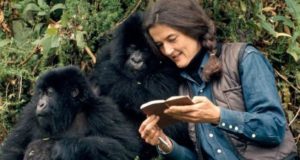 Fossey made the world know more about mountain gorillas and advocated for their protection against extensive poaching. It’s widely believed that without her efforts, mountain gorillas would have been extinct or their numbers drastically reduced. Because of her work and strong conviction, gorilla poaching has been eliminated or reduced considerably in Uganda, Rwanda and DR Congo. Perhaps her greatest contribution was to discover how to make wild gorillas comfortable around human presence. By gaining the trust of mountain gorillas that had been fearful of humans due to large scale poaching, gorilla habituation for many more gorilla groups became possible. Visitors can now see these gentile and amazing creatures up-close instead of talking about some savage creatures living deep in the jungles of Africa.
Fossey made the world know more about mountain gorillas and advocated for their protection against extensive poaching. It’s widely believed that without her efforts, mountain gorillas would have been extinct or their numbers drastically reduced. Because of her work and strong conviction, gorilla poaching has been eliminated or reduced considerably in Uganda, Rwanda and DR Congo. Perhaps her greatest contribution was to discover how to make wild gorillas comfortable around human presence. By gaining the trust of mountain gorillas that had been fearful of humans due to large scale poaching, gorilla habituation for many more gorilla groups became possible. Visitors can now see these gentile and amazing creatures up-close instead of talking about some savage creatures living deep in the jungles of Africa.
Dian Fossey was invited to Africa by the great paleoanthropologist Dr. Richard Leakey to study the life of mountain gorillas in the wild. Dr. Leakey thought that by studying our closest relatives the gorillas, we would understand human origin even better. As Dian Fossey learnt more about the great apes, she channeled her efforts from research to protection and gorilla conservation. Unlike many who think gorilla trekking is ethical, Dian Fossey didn’t recommend gorilla tourism in Africa and thought that gorillas needed to be left undisturbed in their natural habitat. Some of the methods she used for dealing with poachers might have been considered excessive but she always had the interests of the mountain gorillas at heart.
Unfortunately good works also attracts hatred. Dian Fossey was murdered in a remote house on top of the mountains in1985. She was buried next to some of the gorillas she worked so hard to protect. 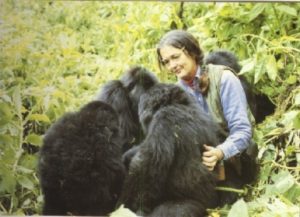 Circumstances surrounding her murder remain a mystery but it’s believed that her murder was related to her strong conviction and desire to end poaching and protect the gorillas. Despite her sad ending, the legacy and work of Dian Fossey remains and her famous book Gorillas in the Mist was later made a film depicting her personal life and work with the gorillas – A must watch. Even with her death, her work was not in vain. The Dian Fossey Dian Fossey Gorilla Fund international (DFGF) continues to work towards the conservation of the mountain gorillas by running several projects including taking care of gorilla groups within East and Central Africa. The number of mountain gorillas keeps increasing. In fact, it is believed that there could now well be over 1000 mountain gorillas living in the vast forests and mountain slopes of Uganda, Rwanda and DR Congo. Before you learn more about how to pay homage to Dian Fossey, you might want to check out our 3 Days Gorilla tour and Dian Fossey memorial hike.
Circumstances surrounding her murder remain a mystery but it’s believed that her murder was related to her strong conviction and desire to end poaching and protect the gorillas. Despite her sad ending, the legacy and work of Dian Fossey remains and her famous book Gorillas in the Mist was later made a film depicting her personal life and work with the gorillas – A must watch. Even with her death, her work was not in vain. The Dian Fossey Dian Fossey Gorilla Fund international (DFGF) continues to work towards the conservation of the mountain gorillas by running several projects including taking care of gorilla groups within East and Central Africa. The number of mountain gorillas keeps increasing. In fact, it is believed that there could now well be over 1000 mountain gorillas living in the vast forests and mountain slopes of Uganda, Rwanda and DR Congo. Before you learn more about how to pay homage to Dian Fossey, you might want to check out our 3 Days Gorilla tour and Dian Fossey memorial hike.
Hiking Dian Fossey’s grave (tomb)
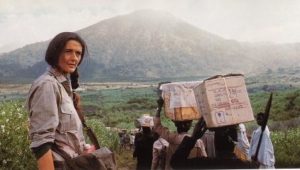 For those who love mountain gorillas, visiting the Dian Fossey tomb and gorilla cemetery located near her former Karisoke Research Camp/center between mount Karisimbi and Mount Bisoke is a must. Gorilla trekking may be the main attraction while on a tour of Rwanda and the volcanoes national park but visiting the grave of Dian Fossey is a unique experience that can be done a day before tracking gorillas (for those who have booked for gorilla trekking in Rwanda). It is a great way to pay homage to one of the greatest mountain gorilla researchers. You will learn about her work with the mountain gorillas in the remote mountains or Rwanda and also contribute towards the very work that she started in 1967. The hike will give you time to reflect on many things and challenge you at a physical, emotional and intellectual level. You might even get inspired to fight for something you truly
For those who love mountain gorillas, visiting the Dian Fossey tomb and gorilla cemetery located near her former Karisoke Research Camp/center between mount Karisimbi and Mount Bisoke is a must. Gorilla trekking may be the main attraction while on a tour of Rwanda and the volcanoes national park but visiting the grave of Dian Fossey is a unique experience that can be done a day before tracking gorillas (for those who have booked for gorilla trekking in Rwanda). It is a great way to pay homage to one of the greatest mountain gorilla researchers. You will learn about her work with the mountain gorillas in the remote mountains or Rwanda and also contribute towards the very work that she started in 1967. The hike will give you time to reflect on many things and challenge you at a physical, emotional and intellectual level. You might even get inspired to fight for something you truly 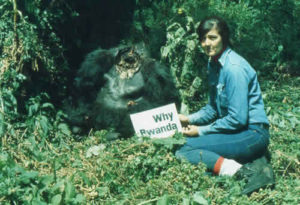 believe in like she did – hopefully relating to wildlife conservation. Besides learning about Dian Fossey’s work and research centre, the activity will give you an opportunity to witness the beauty of Rwanda’s volcanoes national park. While hiking to the tomb of Dian Fossey, you will/might also get a chance to spot rare plants, birds, golden monkeys, forest elephants, buffaloes, antelope and above all a gorilla family along the way.
believe in like she did – hopefully relating to wildlife conservation. Besides learning about Dian Fossey’s work and research centre, the activity will give you an opportunity to witness the beauty of Rwanda’s volcanoes national park. While hiking to the tomb of Dian Fossey, you will/might also get a chance to spot rare plants, birds, golden monkeys, forest elephants, buffaloes, antelope and above all a gorilla family along the way.
Hiking to grave of Dian Fossey isn’t very difficult except for the mud and incline at the starting point that may pose a challenge for the inexperienced hiker – one needs to be at an acceptable fitness level to enjoy the hike. A trek to the Dian Fossey is less packed with visitors compared to the more popular gorilla trekking. However you might want to book in advance especially during the peak months between June and September. 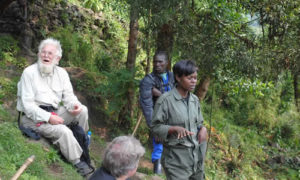 Hiking takes about two hours at most for one in good shape. The hike is usually arranged in the morning hours. Visitors report to the Kinigi park office in the morning for briefing by one of the rangers. The park offices are usually crowded with tourists because it is also where briefing for other activities like gorilla trekking, Bisoke hiking, Karisimbi hiking and golden monkey trekking are carried out. After the briefing, visitors are taken for a 30 minute drive to the foot of the Mount Bisoke (the starting point). While at the starting point, you will meet armed rangers and porters available for hire. The armed rangers help protect you from wild animals and poachers while the porters help carry extra luggage and when navigating difficult terrain. Hiring a porter costs $10. Before embarking on the hike, the chief park guide will assign you a walking stick that will make navigating through some of the difficult sections easier.
Hiking takes about two hours at most for one in good shape. The hike is usually arranged in the morning hours. Visitors report to the Kinigi park office in the morning for briefing by one of the rangers. The park offices are usually crowded with tourists because it is also where briefing for other activities like gorilla trekking, Bisoke hiking, Karisimbi hiking and golden monkey trekking are carried out. After the briefing, visitors are taken for a 30 minute drive to the foot of the Mount Bisoke (the starting point). While at the starting point, you will meet armed rangers and porters available for hire. The armed rangers help protect you from wild animals and poachers while the porters help carry extra luggage and when navigating difficult terrain. Hiring a porter costs $10. Before embarking on the hike, the chief park guide will assign you a walking stick that will make navigating through some of the difficult sections easier.
The hike starts outside the volcanoes national park. After moving for a short while, you will reach the park demarcation and stone walls that keep of buffaloes and elephants from crossing to human gardens. 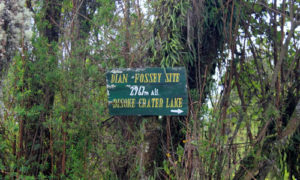 You will follow the same trail used by visitors hiking mount Bisoke. If you are lucky, this trail offers you an opportunity to meet one of the gorilla families. Should you meet one of the gorilla groups, you will be given a very short time to see them from far away – No taking photos allowed. There will be frequent stops to marvel at the beautiful scenes and take photos of important markings. After about 2900 meters of using the Bisoke trail, you will leave for the trail to the Dian Fosey grave. The area around the graveyard and former Karisoke research site offers stunning views of the Virunga ranges and the DR Congo. The Karisoke research camp itself remains neglected and abandoned since the early 1990’s.
You will follow the same trail used by visitors hiking mount Bisoke. If you are lucky, this trail offers you an opportunity to meet one of the gorilla families. Should you meet one of the gorilla groups, you will be given a very short time to see them from far away – No taking photos allowed. There will be frequent stops to marvel at the beautiful scenes and take photos of important markings. After about 2900 meters of using the Bisoke trail, you will leave for the trail to the Dian Fosey grave. The area around the graveyard and former Karisoke research site offers stunning views of the Virunga ranges and the DR Congo. The Karisoke research camp itself remains neglected and abandoned since the early 1990’s. 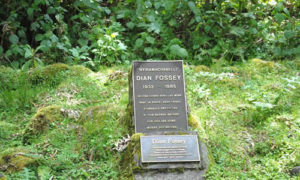 Dian Fossey’s tomb is next to that of her favorite gorilla Digit the silverback and over 19 others. You should also visit the remnants of the house where Dian Fossey was murdered. Take as many photos of the site as possible while asking questions about the work of Dian Fossey from the guides. Lunch is usually prepared near the site as you rest and prepare to descend back to the starting point. Descending back to the head trail takes between 1 to 2 hours. You will find your driver or company guide waiting for you at the starting point to drive you back to your hotel. This is the time you will be separating with your porters and park staff – Tip them for their great work of helping you around.
Dian Fossey’s tomb is next to that of her favorite gorilla Digit the silverback and over 19 others. You should also visit the remnants of the house where Dian Fossey was murdered. Take as many photos of the site as possible while asking questions about the work of Dian Fossey from the guides. Lunch is usually prepared near the site as you rest and prepare to descend back to the starting point. Descending back to the head trail takes between 1 to 2 hours. You will find your driver or company guide waiting for you at the starting point to drive you back to your hotel. This is the time you will be separating with your porters and park staff – Tip them for their great work of helping you around.
What you need for the Dian Fossey grave (tomb) hike
Dian Fossey Hike permits: The first thing you need to do while planning a hike to the grave of Dian Fossey and the Karisoke research centre is to acquire a permit. Hikers are required to show their permits during the briefing just before setting off to the head trail. A permit costs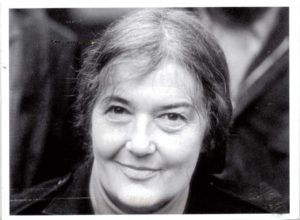 $75 and can be secured from either the volcanoes national park office or the Rwanda tourism offices in Kigali. A portion of the money collected for the permit is channeled to gorilla conservation projects.
$75 and can be secured from either the volcanoes national park office or the Rwanda tourism offices in Kigali. A portion of the money collected for the permit is channeled to gorilla conservation projects.
Accommodation: The choice of which place to stay before and after your hike depends entirely on your choice and budget. There is no shortage of accommodation around the volcanoes national park in Rwanda. We have compiled information about accommodation in Rwanda that you might want to check out here.
Transport: You will need to hire a driver and car to take you to the park offices for registration and to the starting point of the trail. Most visitors tend to use the service of a good tour company like Mission Africa Safaris to help put together the entire tour. Mission Africa Safaris helps clients acquire the hiking permits; organize transport and accommodation among many other services.
Travel documents: You should always move with your identification documents – especially the passport and VISA. You are required to show your identification documents at the park offices before you can proceed to the starting point of the hike.
Hiking Shoes or waterproof boots: The hike takes over 1 hour and the trail can be full of mud and slippery especially during the rainy season. Good hiking shoes help you navigate through difficult terrain. Ensure that the shoes have good grip.
Clothing: Good trousers, long socks, hand gloves and a long-sleeved shirt will help protect against from sharp branches and stinging insects.
Packed snack and drinking water: You might get hungry and thirsty along the way before the lunch prepared at the Dian Fossey Site.

